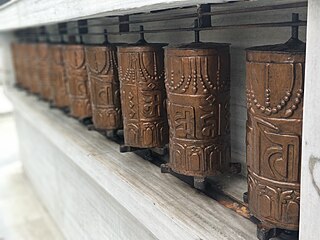
A prayer wheel is a cylindrical wheel on a spindle made from metal, wood, stone, leather, or coarse cotton, widely used in Tibet and areas where Tibetan culture is predominant.

Amitābha, also known as Amitāyus, is the primary Buddha of Pure Land Buddhism. In Vajrayana Buddhism, he is known for his longevity, discernment, pure perception, purification of aggregates, and deep awareness of emptiness. He possesses infinite merit resulting from good deeds over countless past lives as a bodhisattva named Dharmākara.
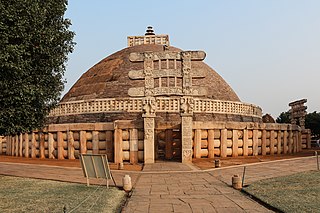
In Buddhism, a stupa is a mound-like or hemispherical structure containing relics that is used as a place of meditation.
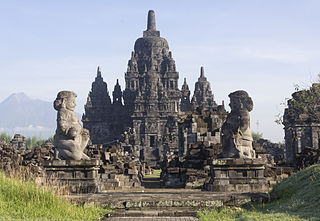
A Buddhist temple or Buddhist monastery is the place of worship for Buddhists, the followers of Buddhism. They include the structures called vihara, chaitya, stupa, wat and pagoda in different regions and languages. Temples in Buddhism represent the pure land or pure environment of a Buddha. Traditional Buddhist temples are designed to inspire inner and outer peace.
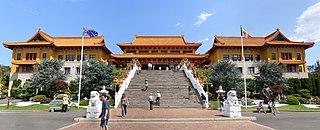
Nan Tien Temple is a Buddhist temple complex located in Berkeley, on the southern outskirts of the Australian city of Wollongong, approximately 80 kilometres (50 mi) south of Sydney.
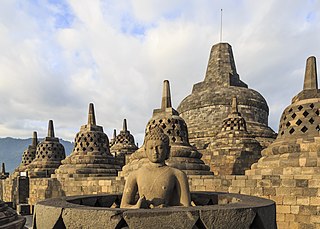
Buddhist religious architecture developed in the Indian subcontinent. Three types of structures are associated with the religious architecture of early Buddhism: monasteries (viharas), places to venerate relics (stupas), and shrines or prayer halls, which later came to be called temples in some places.

In Mahayana and Vajrayana Buddhism, the Five Tathāgatas or Five Wisdom Tathāgatas, the Five Great Buddhas, the Five Dhyani Buddhas and the Five Jinas, are five Buddhas which are often venerated together. Various sources provide different names for these Buddhas, though the most common today are: Akshobhya, Ratnasambhava, Vairocana, Amitābha, and Amoghasiddhi.
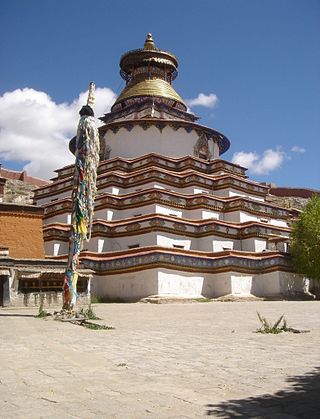
A Kumbum is a multi-storied aggregate of Buddhist chapels in Tibetan Buddhism. The most famous Kumbum forms part of Palcho Monastery.

Swayambhu is an ancient religious complex atop a hill in the Kathmandu Valley, west of Kathmandu city. The Tibetan name for the site means 'Sublime Trees', for the many varieties of trees found on the hill. However, Shingkun may be of in Tamang Bhasa name for the complex, Swayambhu, meaning 'self-sprung'. For the Buddhist Newars, in whose mythological history and origin myth as well as day-to-day religious practice Swayambhu occupies a central position, it is probably the most sacred among Buddhist pilgrimage sites. For Tibetans and followers of Tibetan Buddhism, it is second only to Boudha. Swayambhu is the Hindu name.

GyutoTantric University is one of the great monastic institutions of the Gelug Order.
In Buddhism, a Kalachakra stupa is a stupa whose symbolism is not connected to events in the Buddha's life, but instead to the symbolism of the Kalachakra Tantra, created to protect against negative energies. It is the rarest kind of stupa.
Kardang Monastery or Gompa is a famous Drukpa Lineage monastery, and is the most important monastery the Lahaul valley, India. The associated village of Kardang was once the capital of Lahaul.
The Great Stupa of Universal Compassion is a Buddhist monument near Bendigo in central Victoria, Australia. The basic idea for building the stupa came from Lama Yeshe and then, after Lama Yeshe's death, from Lama Zopa Rinpoche, who decided to model the stupa (kumbum) on the Great Stupa of Gyantse which is 600 years old. When completed, the stupa's exterior will be an exact replica of the Great Stupa of Gyantse. It will be 50 metres (160 ft) high and its four sides will each be 50 metres (160 ft) long, making it one of the largest Buddhist monuments in the Western world. Buddhists say that viewing the stupa will help purify the mind.

Shanti Stupa is a Buddhist white-domed Stupa (chorten) on a hilltop in Chanspa, Leh district, Ladakh, in north India. It was built in 1991 by Japanese Buddhist Bhikshu, Gyomyo Nakamura. The Shanti Stupa holds the relics of the Buddha at its base, enshrined by the 14th Dalai Lama. The Stupa has become a tourist attraction not only due to its religious significance but also due to its location which provides panoramic views of the surrounding landscape.

The Buddha Tooth Relic Temple and Museum is a Buddhist temple and museum complex located in the Chinatown district of Singapore. The temple's monastics and devotees officially practice Chinese Buddhism.

The Fo Guang Shan Buddha Museum, formerly known as the Buddha Memorial Center, is a Mahāyāna Buddhist cultural, religious, and educational museum located in Dashu District, Kaohsiung, Taiwan. The museum is affiliated with Fo Guang Shan, one of Taiwan's largest Buddhist organizations. The museum is located next to the Fo Guang Shan Monastery, the headquarters of the order. The museum houses one of the tooth relics of Sakyamuni Buddha, the founder of the Buddhist faith. The museum was accepted as the youngest member of the International Council of Museums (ICOM) in 2014.
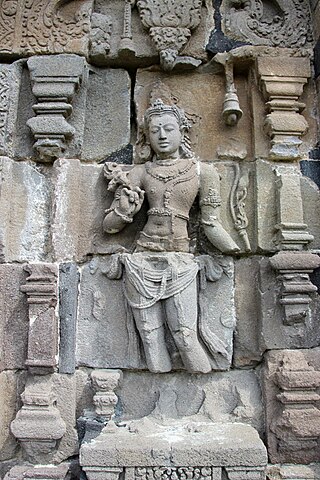
The many different varieties of Buddhist art often show buddhas and bodhisattvas, as well as depictions of the historical Buddha, known as Gautama Buddha.

The Garden of One Thousand Buddhas is a spiritual site near Arlee, Montana, within the Flathead Indian Reservation in Lake County, Montana. Under construction in 2012, the monument portion of the site is 750 square feet (70 m2) in area and the surrounding garden is spread across 10 acres (4.0 ha) of land. It is intended to be a pilgrimage destination for the Western hemisphere and is expected by its builders to become a major place of worship for people of many faiths. It is free to the public and will feature over one thousand statues.

Lingguang Temple is a Buddhist temple located on the east hillside of Mount Cuiwei (翠微山), in the Shijingshan District of Beijing. The temple is renowned for its collection of the tooth relic of the Buddha.
















